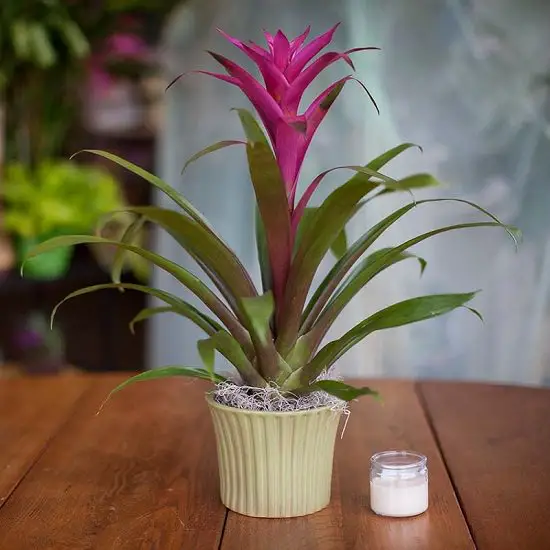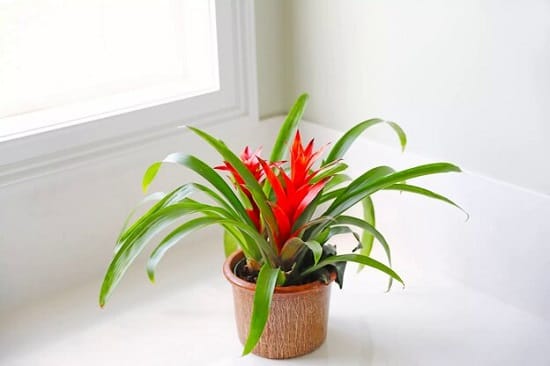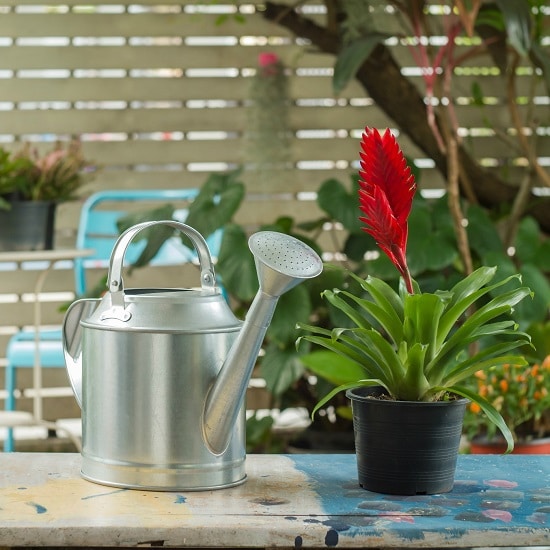Learn How to Care for Bromeliads in this article to grow this stunning air-purifying plant both indoors and outdoors.
Many bromeliads species become beautiful houseplants, including the pineapple plant. Their tolerance to low light conditions, air-purifying ability, and ornamental flowers make them one of the top search indoor plants! If you’re about to grow them in your home or office, it’s essential to learn how to care for bromeliads.
Have a look at the most stunning indoor bromeliad pictures here
Bromeliad Pot Size

Apart from the metal pots, you can go for any material when planting bromeliads. For optimum results, take climatic conditions in your region under consideration. For example, in hot and arid areas, go for plastic pots, as they don’t allow the moisture to seep out.
In humid regions, overwatering is a concern as the soil doesn’t dry out quickly, so go for pots with a porous material, such as clay. Terra cotta pots also offer a great option as they are durable and also soak up excess water.
Overall, when growing bromeliads in pots, the material is not as important as the container size. Since bromeliads have a small root system, most of them love to reside in smaller pots. Our most important tip is to avoid repotting your plant into a large pot. Also, don’t repot until you see the roots peeking out of the bottom or pups at the base.
Best Bromeliad Varieties
Although there are more than 3000+ known species in the Bromeliad family, some of the highly prized ones can grow are from these genera: Guzmania, Vriesea, Aechmea, Billbergia, and Neoregelia.
To know about the best varieties of bromeliads to grow, click here!
Requirements for Growing Bromeliads Indoors
Position

Bromeliads love to reside in bright spots, but some varieties also like to stay in the shade. That being said, all bromeliads are versatile and can do well in both part sun and shaded locations.
The ideal way is to keep it in the sun during morning hours and protect from direct sunlight afterward. An Eastern window or slightly away from the West or South facing window, where it doesn’t receive all-day-long direct sunlight, is also the right place when growing bromeliads indoors.
Soil
The soil should be well-draining. Any fast-draining potting soil will do, as long as it’s not garden soil. You can also make your potting mix using one part peat moss and one part perlite. Mix one part of the tree bark to it to improve it. Adding cocopeat instead of peat moss is also an option.
One more DIY soil mix for bromeliads you can make is by adding succulent mix, orchid bark/fir bark, and compost. Enhance the soil structure of your DIY bromeliad potting soil by adding cocopeat and worm castings to it
Watering

Bromeliads are picky about watering, and they’re more likely to die due to overwatering than underwatering. It’s better to water them only when the topsoil is dry. Pick a pot with drainage holes to allow excess water to drain. Some bromeliads are epiphytic, so instead of pouring, mist water around them to keep them moist.
To know more about how to water the plants, click here
Temperature
These plants can tolerate a wide range of temperatures, but the exact range depends on the bromeliad type you’re growing. Generally, temperature ranging from 55-80F (12-28 C) is considered suitable. Do not expose the plant to a temperature below 40F (5C) as they’re not accustomed to cold climate.
Note: Keep the plant away from direct sunlight.
How to Care for Bromeliads
Bromeliad care is easy in tropics, but in cold climates, you need to be vigilant about some needs. Below are some helpful tips:
Fertilizer

Bromeliads require little to no fertilization. If the quality of soil isn’t poor, you can easily get away with adding compost at the time of planting and later when the plant shows a lack of growth.
Still, if the plant showing it needs fertilizer, use a well-balanced, all-purpose fertilizer, diluted half to its strength once in the growing season. Bromeliads are slow growers, and overfertilization leads to leggy growth and death
Humidity
Bromeliads love humid surroundings, with a 50-60% humidity level in the air. The simplest way is to keep a humidity tray filled with pebbles and water under or next to the pot. You can also use spraying bottles and mist the foliage regularly, but this trick doesn’t work much. A humidifier is the most functional way to raise humidity.
Want to know more about how to increase humidity for your houseplants? Click here
Pruning
There is no specific time to prune bromeliads. Prune away dead leaves and fading flowers of the plant with the help of a shear whenever you see them.
Re-Potting
Bromeliads take around 3-4 years to reach a size where they require repotting. Repot them in one size bigger pot than the previous one, when they outgrow their old planter.
Propagating Bromeliad Pups
Most of the bromeliads die after flowering, but before that, they produce pups. You can notice the pups (baby plants) at the base of the mother plant. Remove them once they are 4-6 inches tall or 1/3 of the size of their parent plant as the roots start to form by that time. Plant them to separate pots, and they will eventually grow and flower.
Pests & Diseases
Root rot and crown rot can be a detrimental disease. Overwatering and overly moist or wet soil is the main reason behind it. Follow our bromeliad watering tips to avoid it.
Common pests like aphids, mealybugs, scales, and spider mites can affect your bromeliads in pots. You can easily manage the minor infestations by handpicking or squirting a jet of water on them. If pests are difficult to get rid of, use organic insecticidal soap or neem oil.
It is also an Air Purifying Plant!
Bromeliads have the ability to absorb the harmful VOCs from the indoor air and according to a recent study, a bromeliad plant managed to clean 80 percent of the pollutants in 6 of the 8 VOCs tested.



What other plants or succulent can be plant with bromeliads?
Thanks for the information. My daughter spent a lot of money trying to grow this plant. This is my first time trying, I want to surprise her if it lives.
I have two healthy Bromeliads given to me a couple years ago as gifts. So healthy the greenery has doubled in size but it has never bloomed since I received them. Should I be cutting them back to force blooms?
Force blooms by setting an apple in pot ( on top of soil) and enclose in a paper bag. Maybe in December/ January.
Are broomliads one time bloomers?